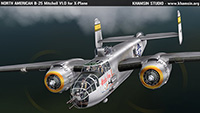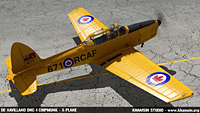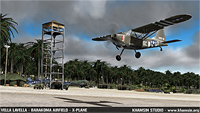Engine management
Due to the switch from XP V9 to XP V10, the followings figures are innacurate. Furthermore, the introduction of SASL to manage the supercharger now allows constant manifold pressure up to 30000ft. Please, refer to the engine management in the cockpit of the plane. This page will be updated asap.
Here are the charts for best performance of the B17G. They are extracted from the original 1942's charts : note that tests did confirm their accuracy in game.
4 engines running
- Absolute Max Ceiling (38350ft) : 45000lb, Full throttle, MPS=10, MP=17, RPM=1650, IAS=135mph (4hours to reach, 4600lb of fuel)
- Max Service Ceiling (36000ft) : 45000lb, Full throttle, MPS=10, MP=21, RPM=1700, IAS=145mph (1.30hours to reach, 2500lb of fuel)
- Max Tactical Ceiling (32500ft) : 63000lb, Throttle 90%, MPS=10, MP=24, RPM=1750, IAS=155mph (1.10hours to reach, 2000lb of fuel)
- Advised Practical Cruise (29500ft) : Throttle 95%, MPS=10, MP=25, RPM=1850, IAS=200mph (range : 1700nm, 10hours)
- Best Cruise without military payload : 24500ft, 55000lb, Throttle 80%, MPS=8.5, MP=26, RPM=1850, 175mph (4x 170lb/H, Theoretical range : 4100nm, 17hours)
- Best Cruise with military payload : 22500ft, 63000lb, Throttle 85%, MPS=9, MP=26, RPM=1850, 170mph (4x 245lb/H, Theoretical range : 2800nm, 12hours)
4 engines running - Supercharger Out-Of-Order
21500ft, Throttle 100%, MPS=10, MP=34, RPM=2350, 150mph, range 300nm, NO POSITIVE VERTICAL SPEED CAN BE ACHIEVED
3 engines + 1 engine feathered
- 45000lb, 24500ft, Throttle 85%, MPS=9, MP=26, RPM=1850, 170mph, range unchanged
- 65000lb, 24500ft, Throttle 90%, MPS=10, MP=29, RPM=2100, 170mph, range-20%
2 engines + 2 engines feathered - (1+4vs2+3 or 2+3vs1+4)
- 45000lb, 22500ft, Throttle 95%, MPS=10, MP=29, RPM=2150, 155mph, range-20%
- 65000lb, 21500ft, Throttle 100%, MPS=10, MP=29, RPM=2100, 170mph, range-50%
2 engines + 2 engines feathered - (1+2vs3+4 or 3+4vs1+2)
UNABLE. Idle at low rpm setting (or stall and feather) the last outboard engine running.
Consider mid-air evacuation of the airplane.
1 engine + 3 engines feathered (2vs1+3+4 or 3vs1+2+4)
-52000lb MAX, 16000ft, throttle 100%, MPS=9, MP=44, RPM=2350, IAS=145mph, VVI=-100ft/mn, range = 300nm to SL.
Consider mid-air evacuation of the airplane.
1 engine + 3 engines feathered - (1vs2+3+4 or 4vs1+2+3)
stall and feather last engine running. Consider mid-air evacuation of the airplane.
4 engines feathered
- 65000lb, Flaps=1/5, IAS=105mph, VVI=-1200ft/mn : Jettison whatever can be. Consider mid-air evacuation of the airplane.
- 45000lb, Flaps up, IAS=115mph, VVI=-650ft/mn. Consider mid-air evacuation of the airplane.
The B17G has 4 powerful and we might add very complex engines. They are designed to deliver 1200 hp at sea level, and up to 1360 hp for a maximum of 5 minutes. Consider that they are able to drive the fully loaded aircraft up to 32,500 ft (at 65000 lb. load-out) and 36,000 ft ( at 45,000 lb.).
PLEASE NOTE : The absolute max ceiling is 38,350 ft but it will nominally take 4+ hours at full throttle to achieve this altitude, and consequently you would arrive at the altitude with less than two hours of fuel remaining. Keeping this in mind, in practice the optimal service altitude is 32,500 ft. Note that climbing up to this FL will take roughly one hour from sea level, and this does not include the time required to carefully run-through the “Cold & Dark” check-lists (you should figure on 20-25 minutes to you carefully work through the check-lists). If you consider making your first flight starting at sea level, climbing to FL325 at proscribed rates of climb, and making your descent and landing at the recommended rates, then you are talking about of a solid 150 minutes total flight duration.
Next, consider that climbing to FL325 is no easy task. As you climb the air gets thiner and thiner and in consequence the engines starve for oxygen and the wings and propellers grow less and less efficient. The fact is, even though the engines are specially designed for high altitude flight, under optimal conditions they will hardly deliver a third of their nominally rated power at FL350.
But what does "specially designed" really mean?
It means there are several special devices integrated into the engines that allow them to run in the very, very thin air encountered at higher altitudes. The principal system for accomplishing this is the supercharger, also known as Manifold Pressure Selector (MPS). This is the big turning button on the pedestal, marked 1 to 10. The MPS directly acts as a turbocharger and as such “recycles” the extremely hot exhaust gases and uses the added “air” thus recovered to compensate for the decreased air pressure at high altitude, thereby directly increasing power. It is important to remember that all superchargers and turbochargers are quite fragile, and procedures followed meticulously to avoid sudden and catastrophic engine failure. CAUTION : any action on any engine setting must be undertaken with extreme caution and in complete accordance with the instructions you’ll find printed on the instrument panel.
The MPS is calibrated in such a way that it delivers its designed power, at the neutral position, at approximately 10,000 ft. Above that altitude power slowly decreases. But what happens when below that altitude?
At or below 10,000 ft, the supercharger generates more power than the engines can withstand, so there is an other device (well, four actually), the Waste-Gates (WG). Basically, the WG are simple valves, allowing over-pressure release from each of the engines without the recycled air being used to “boost” air pressure in the combustion chamber, and thus protecting the engines from an over-torque condition.
IMPORTANT NOTE: There is ONE MPS and FOUR WG. Direct implication: MPS failure will involve all 4 engines, whereas WG failure will only involve the engine it supports. Conversely, consider that engines cannot damage the MPS while WG CAN damage engines.
Finally, there is the torque limiter (TL). Its basic function is to mechanically LOWER the thrust so as to protect the engines at low altitude. So it must be kept on low setting (pulled aft) up to FL120 at least, pushed half-way between FL200 and FL250, and pushed all the way forward above FL320, where you really begin to lack for power.
TIP: If not needed during climb (if, for instance, due to light payload), keep it in the “pulled-back” position up to FL 300.
So what do the throttles act on? Well, the throttles simply act on manifold pressure, nothing else (hence the name of the so-called supercharger, the Manifold Pressure Selector)
By this point you should have have a basic understanding of what engine management is all about, but here is a little recap:
- if you set your engines to deliver inadequate power, you will not reach the altitude you desire and your rate of climb will be very slow;
- set too much power and you will damage the engines, AND to reward your efforts you will not reach the altitude you desire.
- consequently, you must set the correct power at the correct time in order to reach your planned altitude.
If you improperly set engine power, just what kind of damage can you expect to occur?
Well Dude, stuff is going to start breaking. The engines may seize, a propeller shaft may warp and tear apart the engine, or to make the rest of your day as fun as possible an engine will very likely catch on fire, but there are several other equally fun and enjoyable ways to destroy your aircraft’s engines and ensure you get to “hit the silk” for your return to earth...
CHEERFUL DEVELOPER’S NOTE: Even if you DID NOT SET failures in X-Plane, engine failure CAN AND WILL occur if you do not make appropriate power management settings while operating the B17G! These failures are hard-coded into the ACF, and reflect real world operating constraints and conditions. You can avoid these failures only by adhering to the FLIGHT STANDARDS contained in the manual, the checklists, and printed on the main panel.
Keep in mind that for a failure to occur you first have to take some kind of faulty action that leads to an over-power condition. The difficulty with this protocol is simply thus: there is no way to directly read the actual delivered power; you must therefore simply and strictly follow the printed recommendations, and you will find that these are printed on the instrument panel, on the co-pilot’s side, just above RPM gauges.
Again, remember that the engines may deliver up to a full 1360 hp for approximately five minutes. The engines can in fact produce much more power - for a couple of seconds. Then they fail.
Here is a simple summary of what you must and must not do.
What you MUST do:
- If you have the slightest doubt you're over-torquing the engine, CUT THROTTLES IMMEDIATELY. No other action will make the slightest difference unless power is reduced, i.e., the throttles are reduced.
- Make sure that you DO NOT EXCEED the posted RPMs noted on the instrument panel.
- That's all. Cut the throttles !!! (and follows instructions for engines settings on the instruments panel)
What you must NEVER do :
- DO NOT APPLY full throttle at low altitude. This is always a Bad Idea ! The MP (manifold pressure) will exceed 46 inches of mercury (very BAD), maybe 50 or even more (really very, VERY BAD). This will overpressure the WG. As a result, you will watch the WG disengage and reengage repeatedly, and this is a typical occurance on over-powering the engines. At this point any further increase to power settings will seriously damage the engines.
TIP : The normal MP (manifold pressure) is 42 (inches of mercury). Don't exceed this value at any time other than for take-off, when you are allowed 46 for a short period (less than five minutes). In practice, as soon as gears and flaps are up, cut MP back to 42. Remember, Cut The Throttles First (CTTF).
- DO NOT DISENGAGE the WG at low altitude or trying to reengage them after they spontaneously pop-up will over-torque the engine at very high (MP) rates, destroying the propellor shaft, and the engine. You did pack a parachute, right?
TIP : Don't touch the WG! If they “pop on” leave them ON, unless you have discovered another good reason to do something else. This is especially true if you see one popping out without any action taken by you. Setting or resetting the WG to OFF may give you some extra-power for a short time, but it will more likely critically damage the engines. When in doubt, Cut The Throttles First (CTTF).
- DO NOT CHANGE the PROP SPEED when the engine is almost at max torque.
This may cause the torque to increase a little, but getting the engine to over-torque while the prop-drive is in action will cause the drive mechanism to be blocked "as-is". Consequently, the prop drive mechanism may get blocked while in the full low-rpm position (full coarse pitch or even worse yet, feathered), and this is a BAD THING. Even more interesting, the engine may simply seize if the drive doesn’t fail first. Again, this is a very, very BAD THING.TIP : Follow instructions on the instruments panel. Set prop speed carefully, according to MP and to immediate power management needs. Do not disengage the automatic system unless you know exactly why you need to do so. Remember, when in doubt, Cut The Throttles First (CTTF).
- DO NOT SET THE MPS to more than 8 below FL 120 (12,000 feet MSL). Supercharger response is non-linear. There is more added power between 7 and 8 than there is between 6 and 7. Setting the MPS to 9 on take-off is, for instance, quite likely to cause you issues, like crawling out of a twisted pile flaming wreckage.
TIP: Neutral position for the MPS is 7. MPS set to 8 and throttle giving 46 inches of MP (Manifold Pressure) will result in 1350 hp delivered to the shaft. MPS to 8 and 42 inches of MP will give 1200hp (nominal power). Very carefully INCREASE the MPS by 0.1 - from 8 - for each 1000 ft increase in altitude. For example, MPS to 8.5 at FL150, MPS to 9 at FL200; 9.5 at FL250; 10 at FL300. When planning your descent, first set the MPS to 7 and THEN begin your descent. Remember: Cut The Throttles First (CTTF).
- DO NOT PUSH the Throttle Lock forward at low altitude. Basically, pushing the TL has the same effect as increasing MPS by 1 from its current position.
SOME THOUGHTS ON OVER TORQUE CONDITION
What are the main clues that you're over-torquing the engines?
Well, first, if you have a doubt, cut the throttles!
Next, let's try and answer the question.
Here are the main points to consider:
- WG popping out;
- MPS changing settings on its own;
- a rate of climb over 1100ft/mn at SL, over 700ft/mn at FL150, over 250ft/mn at FL300.
- MP above 46 inches
- Speed over 200mph above FL250
Remember : it's best to make FL320 in 2hours, safely, than to seize all four engines 200ft above ground on your first climb. As a result of Alpha testing this ACF before release, we can confidently say that losing two engines on take-off while less than 500 ft AGL will result in a life insurance claim being filed by your beneficiaries.
The Master Caution Light emits a code that should help you diagnose an engine problem anytime one occurs.
It blinks on and off according to pre-coded patterns that give indications. It's a kind of visual morse code, intended to catch your eye and make you aware that something wrong is happening.
There are 3 patterns :
- Light blinking quickly (10x/s): major failure.
Failures to be considered major, and to be checked if this signal turns on, are : - total failure
- engine fire
- partial failure (loss of power)
- fuel flow fluctuation
- shaft failure
- engine seizing
- chip inside the engine
- propeller blast out
- oil pressure going low
- Light turned on, and briefly turning off every 3 seconds (0,1s/3s): fuel shortage
Once the signal turns on, there is less than 500lb left. You should divert to land immediately, B17G have lots of skills BUT they are very poor gliders. - Light briefly blinking on every second (0,05s/1s): engine settings maybe wrong.
You might be either over-torquing or low-torquing the engine. Your first action should be to do nothing at all, check settings, then cut the throttle before you do anything else.
Please note that one blinking pattern may hide another one. For instance, if your engines are about to suck fumes thus turning on the light with very short cuts, you won't see the quick blinking of the engine fire.
Alarms may hide each other!
Have a nice day.
www.khamsin.org - 2014




